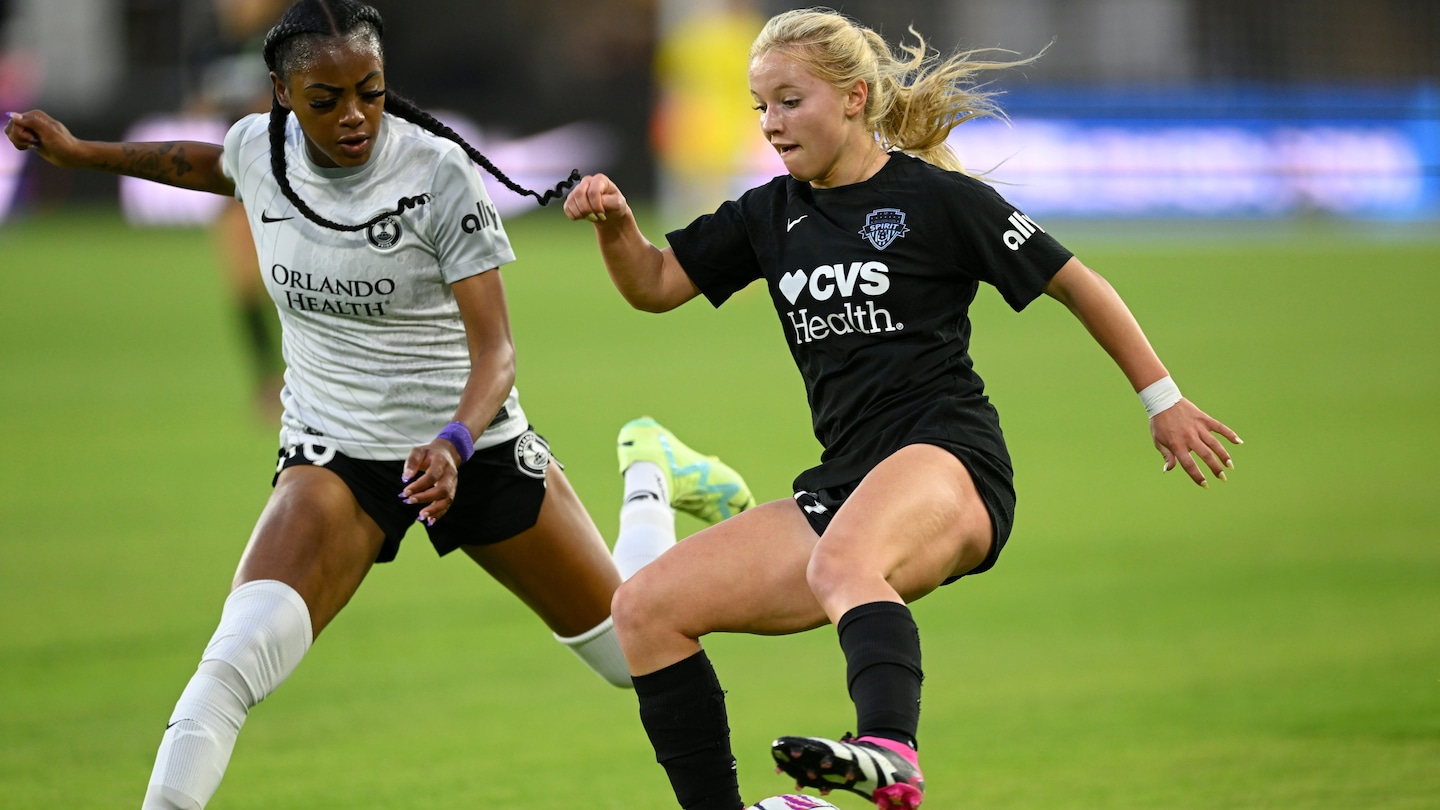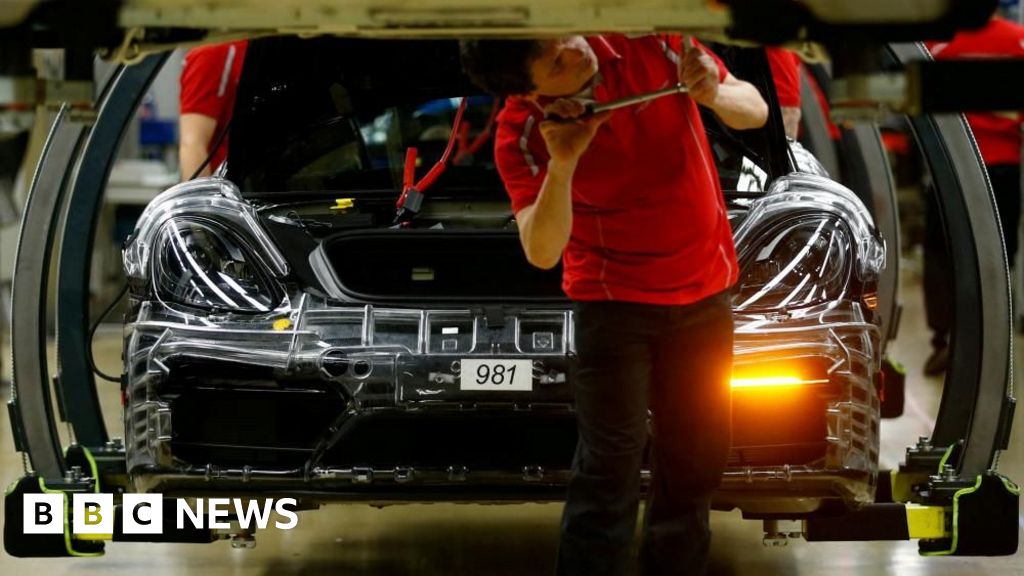
The NWSL’s teen invasion – The Washington Post
- Sports
- June 7, 2024
- No Comment
- 115
“It gets a little funny when I see all them walk past and I have to go to my locker room,” Ricketts said recently, after a rainy morning training session at the Spirit’s facility in Leesburg, Va.
The same scene plays out daily for clubs across the National Women’s Soccer League, where rosters are suddenly sprinkled with teens who practice and play alongside adults. With the NWSL’s minimum age requirement struck down by the courts and clubs desperate to find the sport’s next global stars, a youth movement is rapidly revamping the culture of a league just three years removed from a sweeping abuse scandal, reshaping all levels of women’s soccer in the United States in the process.
Since new protocols governing the signing of underage players were adopted last year, 10 players have entered the league before turning 18, three of whom were just 15 when they signed pro contracts. This season, nearly 1 in 19 NWSL players was younger than 20 when the preseason began, having chosen to skip the college game and, in some cases, bypass high school soccer altogether.
“People are genuinely fascinated by phenoms and young talent,” Jessica Berman, the NWSL commissioner, told journalists recently, acknowledging the teens’ growing role in the league.
Players, coaches and officials across the sport view the trend as an important step toward developing players who can compete on a global stage, including for U.S. national teams. But they’re still grappling with the implications of a rule change that makes the NWSL an outlier among American sports leagues.
The NHL and MLB require most athletes to be at least 18. The NBA’s minimum age is 19; the WNBA’s is 22 for American players; and the NFL requires prospects to be at least three years removed from high school. Only MLS allows American-born players under 18 to sign contracts, and most of those players are assigned to a developmental league or academies specifically designed to develop young talent — a system similar to European soccer.
But the 12-year-old NWSL doesn’t have the funding to support that type of infrastructure, so teens are training and competing side-by-side with players many years older.
League officials and player safety advocates are watching closely. So are college coaches, who are losing top recruits, and U.S. Soccer, a once-dominant force suddenly facing challenges from across the globe.
“As always with these situations, it creates choice,” said Tracey Kevins, the U.S. Under-20 coach and head of development for the women’s youth national teams. “I think where we come from is that we always want the player to be able to make the choice that best suits them. And it is very, very individual.”
It’s also in flux. Around the sport, many acknowledge that more changes are likely, though the specifics of how things shake out are uncertain.
“We’re living through a moment in American soccer where the youth system — this pay-to-play model — is failing,” said Meghann Burke, executive director of the NWSL Players Association. “I think everyone’s trying to figure out what’s the right approach to development. We need to keep kids thinking [that] the reason we play sports is to create healthier lifestyles. … So it’s a system that is still finding its way, and I think we have to be really careful.”
The door was kicked open by Olivia Moultrie, a soccer phenom who began training with the Portland Thorns at 13. Convinced she could succeed as a pro, she sued the league in 2021, claiming its age restriction violated federal antitrust laws because it presented an “unlawful barrier to her participation.”
Moultrie filed the lawsuit just before the league was rocked by a sexual abuse scandal that led to five of the NWSL’s 10 head coaches being dismissed or resigning, including Chicago’s Rory Dames, who was accused of emotional abuse and using offensive language, and North Carolina’s Paul Riley, who was accused of sexual misconduct and verbal abuse. (Both coaches have denied those allegations.)
“I lost a lot of sleep over the idea that we had a 15-year-old young woman trying to get in the league at the same time Paul Riley was still coaching in it,” Burke said. “We couldn’t say: ‘Are you sure? Maybe you and your parents should pump the brakes here. You may not want to come into this league just yet.’ That really wasn’t our story to tell until the players who survived that were ready to speak about it.”
The court granted Moultrie a preliminary injunction, and she later reached a settlement with the league allowing her to play for the Thorns, effectively paving a new path for elite teen players.
“That wasn’t the intent going into it, but of course it’s pretty cool to see the game grow that way,” Moultrie, now 18 and in her fourth season, recently told ESPN, “because that was the intent the whole time: that [if] you’re good enough, you’re old enough. There shouldn’t be some number that’s stopping you from going toward [your goal].”
The league’s age-restriction rule technically remained. But a year later, the NWSL made another exception, allowing 17-year-old wunderkind Jaedyn Shaw to sign with the San Diego Wave. Realizing they needed a formal process to sign teens, league officials created an entry mechanism for the 2023 season allowing teams to sign players under 18 with certain conditions.
It posed a challenge for the league: How do you bring in these new players while clubs were still making sure their players were protected and had proper resources in place?
“It was deeply concerning to me that we had the possibility of children coming into an environment where power imbalances were being abused by coaches against adults,” Burke said. “You put a child in that environment, [and] it’s just horrifying to think about what can happen. Given that we’re only three years removed from that time period and culture is so slow to evolve, we’re still figuring a lot of things out. We ought to be really careful.”
The league settled on a set of protocols. Clubs that sign players under 18 can’t trade or waive them without the player’s and family’s consent. Underage players must shower separately and use a different locker room than the rest of the team. A parent or guardian must live with the teen athlete. And while NWSL players largely share hotel rooms on the road, underage players must bunk alone. Those are just some of the rules. (MLS similarly has guidelines pertaining to players under 18, including optional changing areas and access to showers separate from adult teammates.)
“For better or worse, because of the history of this league, there was a lot of deference in respect to the safeguarding protocols that we put in place,” Berman said. “ … Everybody embraced them, understanding how important it is, because some of the challenges in the past with the culture around girls and women in sport.”
There are other obstacles some clubs must work around. Child labor laws in many states limit or restrict nighttime work after certain hours for anyone under 18.
While college athletes must go through the league’s draft process, teen players are treated more like free agents and are subject to the league’s salary structure. The minimum salary for the league is $37,856 per season, while the average player earns about $65,000.
The first one to take advantage of the new opening: a 15-year-old from Dexter, Mich., who collects reptiles and has a dog named Beretta and was head-and-shoulders better than players her age. She had planned on playing in college until a surprising offer came her way.
Ricketts is in her second season with the Spirit. Her parents are still in Michigan, and she lives in the Washington area with her 24-year-old sister, Vanessa, who doubles as her chauffeur.
This is not how Ricketts envisioned her soccer journey just a few years ago, when she was starring for an all-boys club team back home and weighing the benefits of college. But Spirit General Manager Mark Krikorian learned from a friend in Michigan about a talented teen who appeared ready to make the leap, and he invited Ricketts to a preseason camp last year.
“There’s a lot of talented players,” Krikorian said. “But as soon as you put them into a really competitive environment, well, maybe they’re not quite as mentally strong as they need to be at that level. But that wasn’t the case with her. She came in and she competed very, very well from the beginning and had an edge to her.”
Before long, Ricketts was staring wide-eyed at a contract offer.
“I was like, ‘There’s no way,’ ” she said. “I was overjoyed. … My mom was really hesitant about [it] because — ‘I’m her baby’ is what she said. And she’s like, ‘I don’t want you to leave.’ So that was big for me. But other than that, I was like, ‘Well, I’ll be living my dream.’ ”
Some teens have flourished in the NWSL, adjusting quickly. Moultrie has three goals this season. Alyssa Thompson, 19, is one of the most reliable players for Angel City. Shaw, also 19, has two of the Wave’s nine goals, and Claire Hutton, 18, has started all 11 games for the Kansas City Current and leads the league in tackles.
But for most, there’s an adjustment period on and off the pitch. Ricketts started seven games for the Spirit last year, scoring one goal. This season, she has come off the bench in four games — 18 total minutes — but failed to see any action in seven other games.
Asked about the biggest challenge she has faced, Ricketts said: “Honestly, being away from my family. … My little sister’s my best friend. My dad’s like my hero. So moving away from home was pretty hard for me. Not being able to see them every day and them not being at every single game was hard.”
In Washington, she counts players and staff members as her support system. On a typical day, she has practice and team meetings until about 1 p.m., and then she returns home to do schoolwork. Ricketts is on track to graduate high school early via an online program, and the club helps its players arrange college coursework if they’re interested.
Ricketts said she’s increasingly comfortable on the field. While the team has an average age of 26 and some of her teammates are married or have children, there’s plenty to bond over. (Ricketts and Croix Bethune, the team’s talented 23-year-old rookie, dance together in TikTok videos.)
Shortly after signing with the Spirit, Ricketts signed a multiyear sponsorship deal with Adidas, which made her the youngest female soccer player at the time to do so. At every turn, she said, the team has helped lighten her load — “like we’re taking our time and helping me develop instead of throwing me in.”
“Honestly, I’m not sure this is meant for everyone,” she said. “ … It’s a lot of stress. So I feel like if you know you can handle it and it’s right for you, then you should take that leap. I feel like age is never, should never be an issue. It should never be talked about. I feel like if you’re good enough, you should be able to play.”
While every sport develops its young talent differently, the success of the women’s game in the United States is widely attributed to the opportunities afforded by Title IX. But talent evaluators have long felt the college game was no longer offering women’s soccer players the best training ground. The season is too short, they say, and many games aren’t competitive. The sport has collectively been looking for answers.
“It’s unclear what the future is,” said Berman, the NWSL commissioner. “The college soccer system has inherent challenges within it that most soccer experts would tell you limit a player’s ability to really develop. … And so it can’t be the only place we’re looking.”
On the flip side, though, are teenage players in the NWSL sufficiently developing if they’re stuck on the bench?
“Just being in the pro environment isn’t necessarily a positive for their player development, and it’s not necessarily a positive for their human development,” said Anson Dorrance, the longtime coach at the University of North Carolina. “So at a minimum, if a pro team decides to sign a young player, I’d hope they’d play her.”
Of the 19 NWSL players who were younger than 20 at the start of preseason, only six have started more than six games. Nine have tallied fewer than 200 minutes, with one making a one-minute appearance in a single game and two yet to set foot on the field.
Dorrance has watched plenty of talented teen players turn down UNC scholarship offers or leave school early — from Lindsey Horan to Moultrie to Shaw — and said it’s hard to predict when a young player will come into her own. He fears the financial rewards of a pro career will be too enticing for some teens to pass up.
“I think this is the future. I embrace it. We don’t have a choice,” said Dorrance, who has won 21 NCAA titles, more than any other college soccer coach. “Is it easy for us? No. It’s impossible because the dilemma we’re in, as collegiate coaches, is you kill yourself to recruit one of the top players in the country and then, half a year before she’s supposed to arrive on your campus, you lose her.”
While these increased opportunities might be enticing, college coaches remain bullish on the benefits the collegiate game offers — from a campus environment to athlete resources to a four-year degree. The college game allows players to grow socially around their same-age peers.
“I think U.S. Soccer is very comfortable blaming college soccer for the lack of development, but I don’t think their solution of pushing 16-year-olds to the pro game is necessarily making those kids better players,” said Dave Nolan, the longtime coach at Georgetown. “There’s a human development side to this.”
But coaches still find themselves recruiting against pro teams that can dangle modest paychecks and a lifestyle that is built around soccer. Angela Hucles Mangano, the Angel City general manager, recently traveled to Carson, Calif., to watch the U.S. U-17 national team play. She found herself scouting alongside college coaches and other NWSL talent evaluators.
“That didn’t even happen two years ago,” she said. “Or a year ago, even.”
Officials at all levels of the game acknowledge that a pro contract should only go to the rarest of teenage talents. Krikorian, formerly the longtime coach at Florida State, said “that 99 percent of the kids ought to go to college.”
“They’re great developmental years. I look at my own children in that and I see … that those college years are so important,” he said. “ … I’m a big proponent of the university system, the college system. I think it’s great. I think for a lot of years, it has served U.S. soccer very, very well. But now there’s another path, and this other path, for the right kid, may be the right path.”
And it’s increasingly the path where U.S. Soccer sees value as it pushes to keep up with the evolving global game. Many European clubs have stockpiled talented teen players, assigning them to youth academies or developmental teams. At last year’s World Cup, the American squad that was knocked out in the round of 16 was 3½ years older than that of Spain, the eventual champion, and featured just one player under 21. (The Spanish national teams, in fact, are the defending champs at three age levels: senior, U-20 and U-17.)
U.S. officials knew changes needed to be made. The national team roster for this month’s friendlies included two teenagers: Shaw and Lily Yohannes, a 16-year-old from Virginia who plays for Dutch club Ajax. A third, Moultrie, was invited to train with the squad.
The U.S. squad that competed at the U-20 World Cup in 2022 featured two professionals, while the 2018 team had zero. Its current roster features seven players who turned pro as teens. And the most recent U-17 roster was the United States’ first to include professional players: 16-year-old Melanie Barcenas from the Wave and 16-year-old Alex Pfeiffer from the Current.
The latest U-15 roster includes one player who has said college and even high school soccer aren’t in her plans. Mckenna Whitham, a 13-year-old forward from California, already has a Nike deal and has trained with three pro clubs but has yet to sign a contract. Suiting up for Gotham, she scored a game-winning goal during a February preseason game in Colombia.
Many stakeholders are hopeful that as the economics underpinning the sport continue to grow, there soon will be more structural changes — youth academies run by each club, perhaps, or developmental teams or secondary divisions where talented teens can get more game experience.
Tatjana Haenni, the NWSL’s chief sporting director, has a background steeped in European football with stops at UEFA, FIFA and most recently heading up the Swiss Football Association. She watched as the women’s game overseas followed the men’s model, with professional clubs signing players at a young age and developing them through academies or developmental leagues.
“As a league, we are looking at this right now — we want to solve and create a youth player pathway,” Haenni said. “I’m analyzing and working with the board and the competition committee and all our clubs. What can we do in the future that is meaningful but also sustainable? Clearly, we need a youth development pathway, we need a reserve team or a development team where we can make sure more of the young players are in an elite player development environment but they also can play.”
The protocols governing the teen players were not collectively bargained, and Burke said it is likely to be an issue when the current agreement expires at the end of 2026.
“I do think there’s a little bit of an overcorrection happening,” Burke said. “The league had this ban for so long — an outright ban — that didn’t necessarily have a logical basis. And now we’ve gone to the other extreme, where clubs really place a value on 15-, 16-, 17-year-old kids. We don’t yet know what that trajectory in life span looks like. If you turn pro at 15, do you have the same length of a career as someone who is 21 or 22? Do you have a better career? We just don’t know.”
#NWSLs #teen #invasion #Washington #Post









